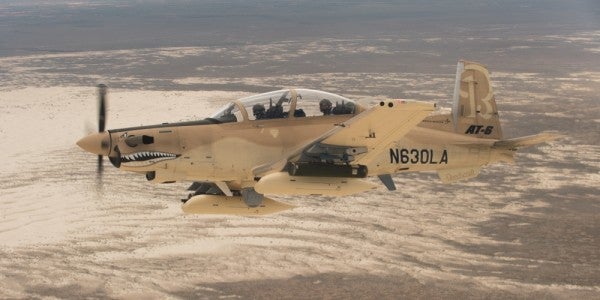The Air Force Could End Its Light Attack Aircraft Experiment Following A Fatal Crash
The future of the Air Force’s light attack aircraft experiment is unclear following the recent crash of an A-29 Super...

The future of the Air Force’s light attack aircraft experiment is unclear following the recent crash of an A-29 Super Tucano that killed a Navy pilot.
The Air Force has been working with the Navy and Marine Corps to test relatively cheap propeller-driven aircraft to fly fighter and attack missions against enemies without sophisticated air defenses. The goal is to free up more technologically advanced aircraft to go after targets defended by modern radars, missiles, and fighter jets.
Since early May, the Air Force has been testing A-29s and AT-6B Wolverines at Holloman Air Force Base, New Mexico. Air Force Gen. Mike Holmes, head of Air Combat Command, told reporters that both type of aircraft remain grounded pending an investigation into the June 22 crash that killed Navy Lt. Christopher Carey Short.
“Because there’s no operational mission here we’re able to take a pause and wait until we get at least the initial indications of what happened,” Holmes said at a June 28 Defense Writers Group breakfast, adding that it is too early to say if the light attack experiment will be delayed or cancelled.
Air Force officials are currently determining whether they have enough data from the experiment or if further testing is needed.
“I think we’ll take a look at the data we’ve gathered; we’ll continue ahead with our process toward deciding whether we want to go forward with the program,” Holmes said. “I am not concerned that the accident will have an undue effect on how we go forward.”
The light attack experiment is in its second phase, which, according to Holmes, is focused on how many sorties the aircraft can fly, how to sustain the planes, and how much money would need to be budgeted for the program.
Should the experiment continue, Air Force officials will decide whether further precautions are needed only after the cause of the June 22 crash is determined.
“I can’t really say much about the accident because a safety board is stood up and we use safety privilege to protect the people that were involved,” Holmes said. “We’re certainly very sad about the loss of Lt. Chris Short, a great aviator who was dedicated to trying to find out what the answers were about: Can we use this airplane in some circumstances to free up our more sophisticated fighters?”
Other nations such as Afghanistan use the A-29 for a variety of mission types, including close air support. Since June 12, the Afghan air force has flown 38 sorties against the Taliban in self-defense, nine of which were flown by A-29s, said Army spokesman Martin O’Donnell, a spokesman for Operation Resolute Support.
Holmes said he was not concerned that whatever caused the June 22 crash might affect the Air Force’s entire fleet of A-29s and that it was “premature to talk about what exactly happened.”
“It’s a learning process,” Holmes added.“Unfortunately, some of that learning happens the hard way.”
WATCH NEXT:
